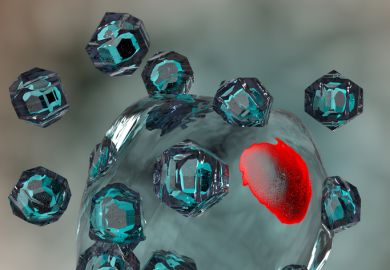What will be big in 21st-century science? Harold Kroto and Humberto Terrones have seen the future, but can it be made to work?
Materials science has made some of the most valuable and humanitarian technical contributions to the quality of life in the past century. As we start the new one we are encouraged to look at its future and see it in relation to these past achievements.
Undoubtedly one of the most important fundamental discoveries of the past century was that of X-ray diffraction by Max von Laue in 1912 and the subsequent application of the technique to the determination of the ways atoms are arranged in crystalline materials by the Braggs. The impact of this discovery on our understanding of organic and inorganic materials as well as on proteins, and, of course, DNA in particular, is little short of breath-taking. X-ray techniques can explain why diamond, a carbon, is so hard, can be used in cutting devices and expensive jewellery, and does not conduct electricity. It also explains why graphite, another carbon, is soft, conducts electricity and is a good lubricant (except in a vacuum). The differences in behaviour originate from the differences in the carbon atomic arrangements.
X-ray diffraction patterns indicate that each carbon atom is surrounded by four others in a tetrahedral 3D arrangement, whereas in graphite each carbon atom has only three trigonally arranged nearest neighbours forming a hexagonal-patterned flat "graphene" sheet - rather like a chicken-wire network.
All this has been known for decades. But in 1985 carbon came up with a surprise: it can also form discrete molecules in which 60 carbon atoms make up a closed-cage network with the same pattern as a modern football. The pattern is similar to that in graphite, in that each atom has three nearest neighbours, but now the hexagonal rings, of which there are 20, are interspersed with 12 pentagonal ones. This C60 molecule was called Buckminsterfullerene after the American designer of the famous geodesic domes.
The discovery led to a major advance. It was realised that closed all-carbon cage structures of all shapes and sizes were possible, and in 1991 Sumio Iijima, in Japan, found that graphite could form closed cylindrical cages with very small nanometre diameters - the famous carbon nanotubes or "Bucky tubes". The discoveries have opened vast new areas of research in chemistry, physics and materials science and their potential applications in nanotechnology, such as electronic nanodevices, new strong composite materials, high-performance magnetic recording devices, flat-panel television displays, protective cages for radioactive materials and new compounds.
This book by Peter F. Harris reviews the properties of the carbon nanotubes and clarifies their promise as revolutionary new materials for the 21st century. It is a most readable and useful book, which contains a wealth of up-to-date information for specialists and non-
specialists. It highlights the main challenges that have to be overcome if carbon-based nanotube technology is to fulfil the exciting, indeed revolutionary promise that the already-known properties have forecast.
An introductory chapter prepares the non-specialist by presenting an overview of the fascinating world of carbon nanotubes. The range of different structures that carbon cages can form is described, starting from the discovery of the spheroidal C60 to the cylindrical nanotubes that can possess so-called "zig-zag", "armchair" and chiral dispositions of the carbon atoms in the walls. The second chapter presents a detailed review of the various known synthetic approaches to creating carbon nanotubes - for example, arc discharge, pyrolysis, laser vaporisation and electrolysis. This information is very useful for research groups interested in exploring further related experiments and also for training researchers starting in the field. As explained in this chapter, depending on the production method, carbon nanotubes can be multi-layered or single-walled. However, with our present knowledge we cannot yet control the main tube parameters, such as number of layers, length and quality of the tubes. Indeed the growth mechanisms are really not well understood. This is a major problem that will need to be solved if nanotubes are to have important applications.
From the straightforward explanation of the structures of the straight carbon nanotubes that can be synthesised, Harris goes on to show how different shapes, such as tori and coils, can occur. These structures can be explained by the disposition of pentagonal and heptagonal disclinations in the hexagonal mesh. Heptagons introduce saddle-point negative curvatures, whereas pentagons produce the round-closing positive curvatures. Here a little more explanation would have been useful for the non-specialist, since disclinations, or more exactly groups of them, can result in a wide range of different shapes with exciting properties.
Depending on the diameters and the exact way graphene sheets are rolled up (that is, the chirality of the hexagon rings in the nanotube walls), the nanotubes may be conductors or semiconductors. For example, all armchair nanotubes are metallic while some zig-zag ones are metallic, and others may be semiconductors. Chapter four addresses such important electronic/electrical properties of carbon nanotubes and explains the theory of why the band structure depends on the chirality of the tubes. In fact, experiments have confirmed the theoretical predictions of the conductivity properties of nanotubes. Indeed, they have shown that conduction in single-walled tubes is quantised, so it occurs through well-separated discrete electronic states. In addition, electrons can flow without experiencing distortions from impurities. These electronic properties make carbon nanotubes unique.
This chapter also provides an account of the recent theoretical and experimental results on other less well-investigated physical properties of nanotubes, such as their optical, vibrational and magnetic behaviour.
Experiments have further shown that the cylindrical cavities in carbon nanotubes can be filled with atoms and compounds - for example, metal cores, gases, carbides, biological molecules and even rows of C60. These hollow carbon structures can be used not only as test tubes, but also to locate molecules on their surfaces. In chapter five, different methods for opening and introducing materials into the tubes are surveyed. Although the filling mechanisms are not well understood, the most recent research has shed some light on the directions to follow in order to achieve fully filled nanotubes. These are the first steps towards the creation of nanowires that may enable the next generation of electronic devices to be realised, for instance molecular computers.
Nowadays, commercial carbon fibres are used in the fabrication of advanced materials that can withstand the excessive stresses that occur in aircraft, cars, tennis rackets and so on. The stiffness of these fibres originates partly from the fact that the C-C bond in the graphitic basal plane is the strongest in nature. The first part of chapter six is devoted to an explanation of the structure and properties of these commercial carbon fibres that consist of graphitic carbon. These are very much larger than the nanotubes and significantly less well ordered. In a sense, carbon nanotubes, as Harris explains, constitute the ultimate carbon fibre since they possess the smallest ordered arrangement of carbon atoms that can form a cylinder. So far as their mechanical properties are concerned, carbon nanotubes exhibit the highest known Young's modulus, which means they are the stiffest structures known so far. If and when pre-ordained structures can be fabricated from carbon nanotubes, either in bundles or some other well-ordered configurations, they will exhibit tensile strengths some 50 to 100 times greater than steel and will be more than 80 per cent lighter. The second part of this chapter discusses the possibility of producing composite materials consisting of nanotubes bonded into polymer matrices. This approach to exploiting the exceptional properties of nanotubes, such as their strength and/or their conductivity in matrix materials, is possibly the first step in the birth of a new generation of advanced high-performance materials.
But not all is in the future. Carbon nanotubes have already been used successfully as scanning probe tips in atomic force microscopy as well as in scanning tunnelling microscopy.
Carbon is not the only atom that can form such tubes, and in chapter seven Harris discusses other layered materials such as boron nitride, metal dichalcogenides, chrysolite and imogolite, all of which may form them too, as well as polyhedral cages. The properties of these materials are the subject of much ongoing research that has still a long way to go. After carbon nanotubes, boron nitride nanotubes are the most well studied; they also exhibit very high stiffness, though not as high as carbon, and appear always to be semiconducting. Hollow tungsten and molybdenum disulphide nanoparticles have proven to be excellent lubricants. Research is going on that explores a range of boron, carbon and nitrogen-containing tubes and wires. The results are quite promising and the area of bent-
layered materials, in particular, will certainly develop fruitfully in the 21st century.
The graphene sheet is such a versatile construct that besides forming spheroidal (more or less) fullerenes and their elongated cousins the nanotubes, it also forms spheroidal concentric onion-like shell structures.
In chapter eight these structures are discussed in detail, in particular how they are produced in the beam of an electron microscope. Under intense irradiation the atoms rearrange by knock-on effects that produce metastable onion-like objects. They are metastable because when the irradiation stops, the exterior layers tend to change, losing their spheroidal shapes as they metamorphose into amorphous structures. Although studies of this behaviour are only just beginning, further investigation seems appropriate as it has been shown recently that high-power irradiation at high temperatures can cause the interiors of such objects to transform into diamond domains.
We agree fully with Harris, as he explains in chapter nine, that we are at the beginning of a new era in carbon science. However, we must add that other layered materials can result in interesting intricate arrangements that are likely to have important uses in the future.
To sum up, the book is well written and presented with illustrations and diagrams that bestow an excellent visual style. These lend the monograph a professional feel that engenders a fully justified confidence in the author's scientific judgement and ability. This is because Harris has himself made important contributions to this field. Thus the book is full of relevant, up-to-date information for both the specialist and the non-specialist about an exciting and promising, yet highly demanding field that is exploding. When the book was written, the publication rate on nanotube research was about one paper per day - now it is nearly two per day.
The well-chosen figures are culled from the most influential research papers in the field. The references are recent and as complete as is feasible. The book demonstrates quite clearly that what has been achieved so far is but the tip of a massive iceberg and that the nanotechnology of layered materials promises to have a revolutionary impact on materials science. It also clearly details the range and scale of the problems that must be solved if we are to create structures with tensile and electronic properties that approach the ultimate performance possible with materials consisting of atoms linked by chemical bonds. Certainly, in the 21st century, nanotubes are likely to become at least as familiar as any of the materials we have now, natural or man-made; and if what we already know is anything to go on, they are destined to be much more valuable.
Sir Harold Kroto, Nobel laureate, is Royal Society research professor, and Humberto Torrones is visiting research professor from the institute of Physics, UNAM, Mexico, University of Sussex.
Carbon Nanotubes and Related Structures: New Materials for the 21st Century
Author - Peter F. Harris
ISBN - 0521 55446 2
Publisher - Cambridge University Press
Price - £50.00
Pages - 9
Register to continue
Why register?
- Registration is free and only takes a moment
- Once registered, you can read 3 articles a month
- Sign up for our newsletter
Subscribe
Or subscribe for unlimited access to:
- Unlimited access to news, views, insights & reviews
- Digital editions
- Digital access to THE’s university and college rankings analysis
Already registered or a current subscriber? Login



